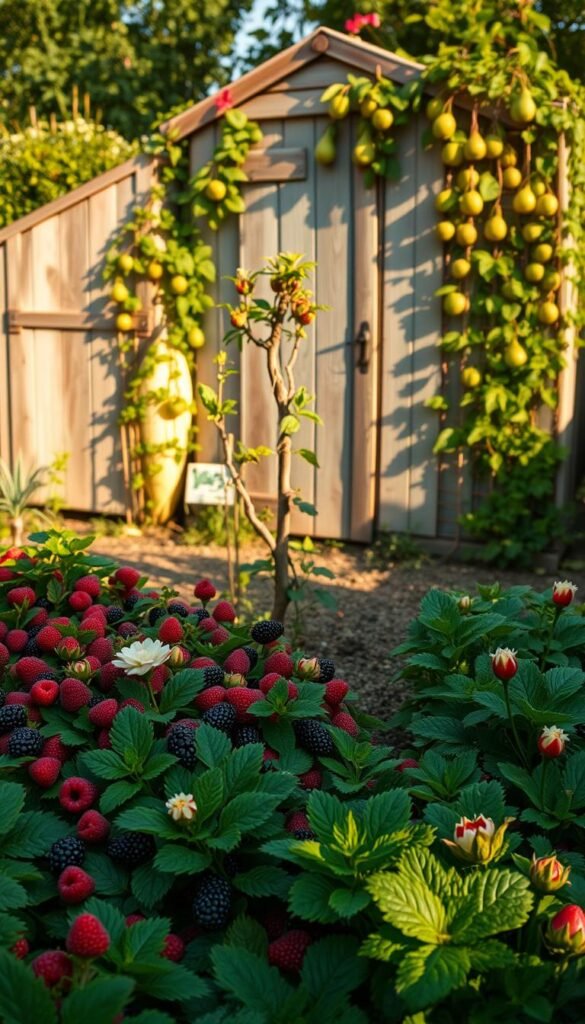Imagine stepping outside to pick sun-warmed berries or crisp apples from your own back yard. Growing edibles at home brings unmatched freshness and flavor while cutting grocery bills. Unlike store-bought produce harvested early, your homegrown treats ripen fully on the plant – nature’s candy at its sweetest.
Creating a productive fruit garden demands strategic thinking. Unlike vegetables, most fruiting plants live decades. Your choices today shape harvests for years. Space-efficient growing techniques let even balcony gardeners enjoy juicy rewards. Modern methods pack more plants into tight areas without sacrificing yield.
You’ll discover environmental perks too. Homegrown means zero plastic packaging and fewer food miles – your snack travels steps, not continents. Teach kids about food origins while enjoying pesticide-free snacks. Though trees need patience (think 5+ years for full crops), dwarf varieties and container gardening speed up the timeline.
This guide helps navigate pollination needs, pest solutions, and smart plant placement. Whether you’re working with a patio or postage-stamp lawn, you’ll learn to maximize every inch. Let’s turn your outdoor area into a productive paradise that keeps giving season after season.
Understanding Your Garden Space and Planning Needs
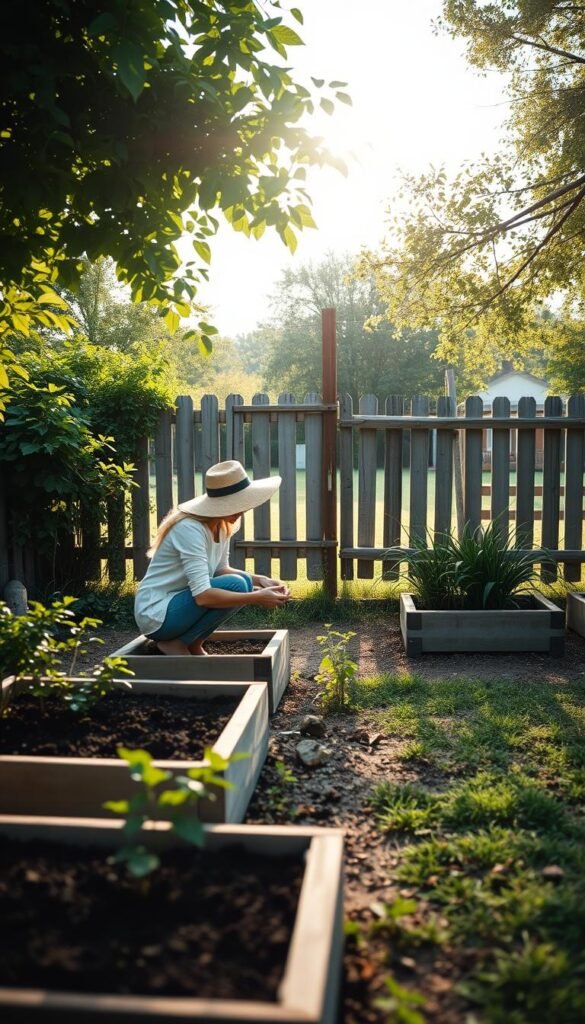
Successful fruit growing starts with smart preparation. Unlike annual crops, trees and bushes become permanent fixtures that shape your outdoor area for decades. You’ll want to balance family preferences with practical growing conditions to create a thriving edible landscape.
Sunlight and Soil Essentials
Most fruit plants demand full sun – at least 8 hours daily. Track shadows throughout the day using free apps like Sun Seeker. Test soil drainage by digging a 12″ hole: If water remains after 24 hours, consider raised beds. Local extension offices often provide affordable pH testing kits.
Choosing What to Grow
Create a wishlist of favorites, then research their needs. A single apple tree might satisfy a family’s fresh-eating habits, while blueberries require multiple plants for cross-pollination. Use this table to compare options:
| Fruit Type | Mature Size | Sun Needs | Pollination |
|---|---|---|---|
| Dwarf Apple | 8-10 ft | Full | Partner required |
| Blueberry Bush | 4-6 ft | Partial | 2+ varieties |
| Fig | 10-30 ft | Full | Self-fertile |
| Strawberry | 6-8″ | Full | Self-fertile |
“Always plant for the tree’s final size, not its nursery pot dimensions,” advises horticulturist Linda Chalker-Scott. “That cute sapling becomes a 30-foot giant in 15 years.”
Sketch your space showing mature plant spread and seasonal shade patterns. Leave room for maintenance paths – you’ll thank yourself come harvest time!
Selecting Fruit Varieties and Planting Techniques
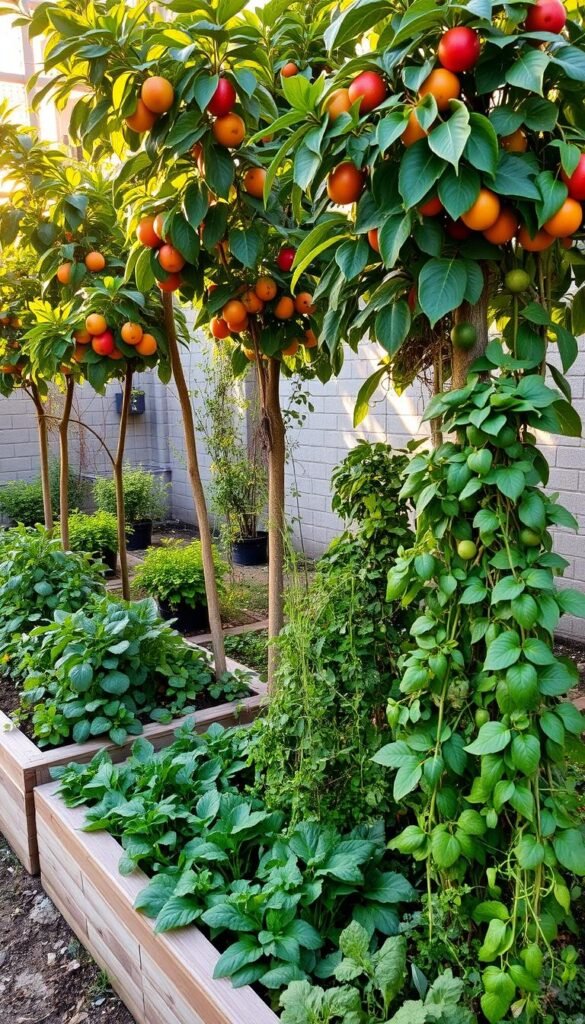
Your space doesn’t limit your harvest potential when you choose smart-growing plants and techniques. Compact varieties and creative layouts let you enjoy fresh snacks without overcrowding your area.
Size-Controlled Options for Tight Areas
Dwarf fruit trees thrive in spaces as small as 4×4 feet. Genetic dwarfs stay naturally compact, while grafted types use special rootstock to limit growth. Check mature sizes carefully – some “dwarf” cherries still reach 15 feet!
| Rootstock Type | Max Height | Best For |
|---|---|---|
| M27 (Apple) | 6-8 ft | Containers |
| St. Julien A (Plum) | 10-12 ft | Small yards |
| Pixy (Peach) | 5-6 ft | Raised beds |
Growing Up Instead of Out
Train trees vertically using espalier techniques along fences. Grapes and passionfruit climb pergolas beautifully. For containers:
- Use 20+ gallon pots with drainage holes
- Mix 40% potting soil, 30% perlite, 30% cocopeat
- Prune roots every 2 years during repotting
“Container-grown figs often outproduce ground-planted ones when given proper care,” notes urban orchardist Marco Hernandez.
Pair early and late-season varieties to extend harvests. Always confirm pollination needs – some fruit shrubs require partners, while others self-pollinate.
Preparing Soil and Employing Sustainable Practices
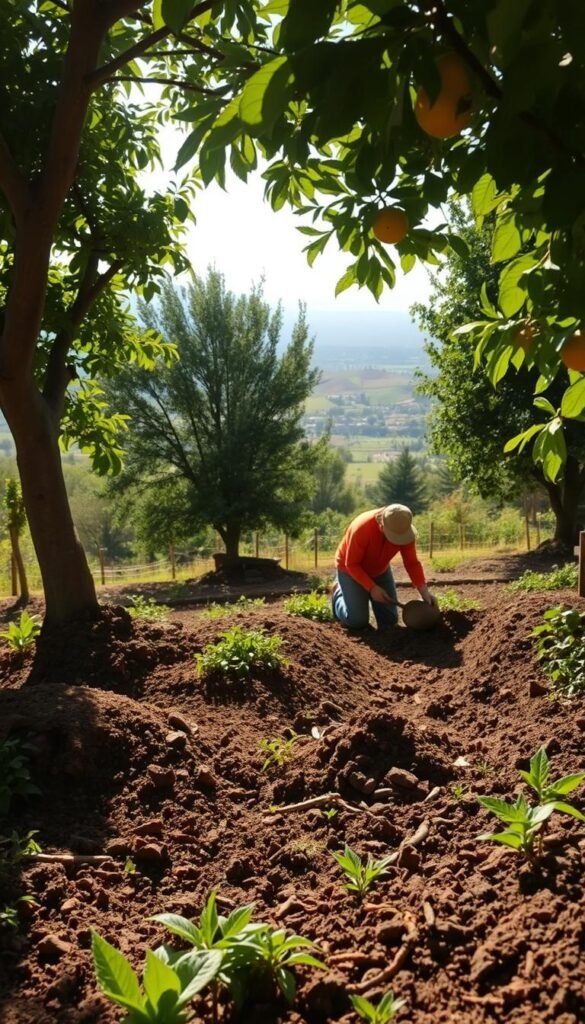
Healthy soil forms the foundation of thriving fruit plants. Like building a house, what happens below ground determines your garden’s success above it. Let’s explore techniques to create living, breathing earth that supports robust growth for years.
Improving Soil Fertility With Compost and Nutrients
Start by mixing 3-4 inches of compost into planting areas. This “black gold” feeds microorganisms while improving drainage and moisture retention. Test your soil annually – most trees prefer slightly acidic conditions (pH 6.0-6.5).
| Organic Material | Nutrients Added | Best For |
|---|---|---|
| Aged Manure | Nitrogen, Potassium | Young Plants |
| Leaf Mold | Carbon, Minerals | Acid-Lovers |
| Biochar | Long-Term Carbon | Heavy Clay |
“Compost acts like a multivitamin for your garden,” explains soil scientist Dr. Ellen Peters. “It releases nutrients slowly, matching plant needs throughout the season.”
Managing Water, Drainage, and Air Circulation
Dig wide planting holes – at least twice the root ball’s size. This prevents water pooling around delicate feeder roots. For container plants, use pots with multiple drainage holes and elevate them slightly.
Water deeply but infrequently to encourage downward root growth. Morning irrigation reduces evaporation and fungal risks. Regenerative gardening methods help retain moisture naturally through mulch layers.
Position plants where gentle air movement discourages pests without causing wind damage. Avoid low spots where frost lingers – even 10 feet elevation difference can protect spring blossoms.
How to Plan a Small Fruit Garden for Limited Spaces: Detailed Strategies
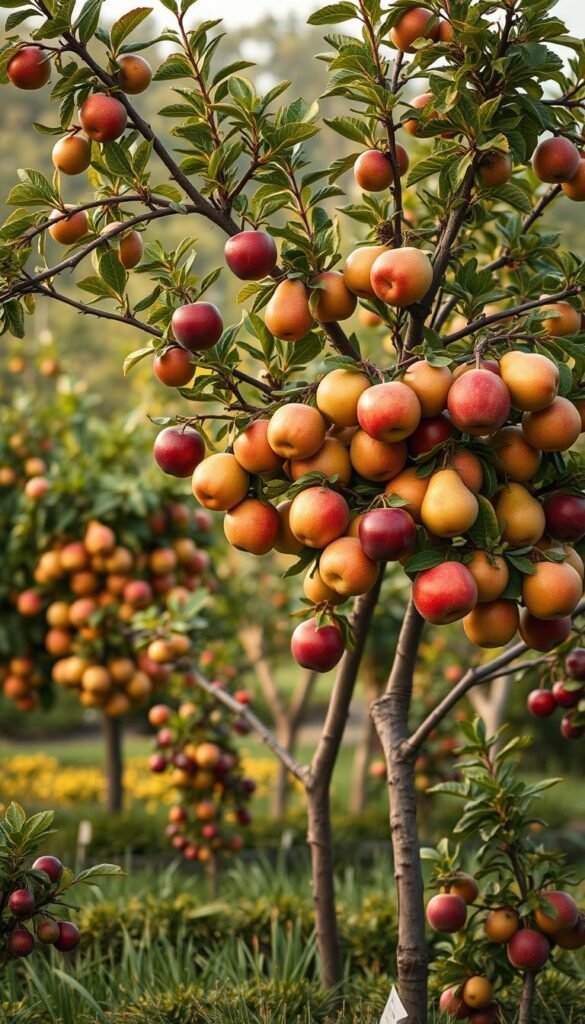
Transform tight quarters into abundant orchards through strategic planting methods. The secret lies in leveraging nature’s patterns and modern horticultural innovations. Let’s explore techniques that multiply your harvest without expanding your footprint.
Mastering Microclimate Magic
South-facing walls become natural radiators – perfect for figs or peaches. North sides host cool-loving currants. Track winter sun angles using free tools like SunCalc. Stone walls release stored heat at night, protecting early bloomers from frost.
The Multi-Fruit Tree Revolution
Grafted specimens let you grow apricots, plums, and cherries on one tree. These living mosaics require careful pruning but offer incredible variety. Consider these popular combinations:
| Rootstock | Grafted Varieties | Harvest Window |
|---|---|---|
| Apple M111 | Fuji, Gala, Granny Smith | Aug-Oct |
| Stone Fruit | Peach, Plum, Almond | May-Aug |
| Citrus | Lemon, Lime, Orange | Year-Round |
“A well-grafted tree becomes a living fruit basket,” says orchardist Mia Torres. “Just remember – each variety needs equal light access to thrive.”
Circular Planting Systems
Cluster 3-4 fruit trees around a central compost trench. Their roots share nutrients while competing for space – a natural size control method. Maintain 18″ between trunks and prune outward-facing branches. This method works beautifully with dwarf pears or columnar apples.
Train espaliered trees along wire grids on wall fence surfaces. This ancient technique modernizes small-space growing, turning vertical surfaces into edible tapestries. Pair with reflective mulch to boost light levels by up to 30%.
Smart Techniques for Maximizing Crop Yields in Tight Areas

Boost harvests without expanding your plot using vertical and temporal techniques. These methods let you grow more food in the same footprint by working with nature’s layers and growth cycles.
Intercropping, Stacking, and Integrated Planting
Pair quick-growing crops with slow-developing fruit trees to double your yield. Sow radishes or spinach between young saplings – they’ll mature before tree roots expand. Try these winning combinations:
- Strawberries under blueberry bushes
- Pole beans climbing dwarf apple trunks
- Leafy greens circling fig tree bases
Stack plants vertically like a living skyscraper. Tall trees form the canopy, with berries mid-level and herbs at ground cover. This maximizes your garden’s potential by using every inch of airspace.
| Layer | Plants | Yield Boost |
|---|---|---|
| Canopy | Peach/Pear | Shade protection |
| Mid-Level | Currants/Goji | Wind buffer |
| Ground | Thyme/Chives | Pest control |
Adapting Pruning and Training Methods
Flatten fruit trees into living fences through espalier training. This technique redirects energy into fruit production instead of branch growth. For tight beds, try single-stem cordon apples – they produce full-sized crops in 18″ of space.
“Proper pruning turns one tree into a multi-season producer,” says arborist Gina Marlow. “Summer cuts control size, winter cuts shape next year’s harvest.”
Time your trims strategically. Remove vertical water sprouts in June to slow expansion. Thin overlapping branches in January to improve air flow. Pair with reflective mulch to boost light penetration by 40%.
Year-Round Harvest through Succession Planting and Seasonal Adjustments
Your compact orchard can deliver sweet rewards nearly year-round with clever scheduling. By pairing staggered planting dates with multi-season varieties, you’ll turn limited space into a nonstop snack bar. Let’s explore techniques that keep your basket full from spring blossoms to winter dormancy.
Sync Plants with Nature’s Calendar
Start with everbearing strawberries that produce from June through October. Follow with late-summer raspberries and fall-bearing apples. In warmer zones, citrus trees offer winter fruit when other plants rest. Track your area’s frost dates using USDA zone maps to avoid blossom losses.
Rotate container-grown figs indoors during cold months for extended harvests. Plant dwarf blueberries in pairs – early and late varieties stretch the picking window. This approach ensures something’s always ripening, even in small spaces.
Boost Productivity with Seasonal Tweaks
Prune summer-bearing fruit trees in late winter to encourage new growth. Protect spring blooms from late frosts using row covers. Mulch heavily before summer heat to retain moisture. Come fall, add compost to nourish next year’s buds.
Remember: most plants need 2-3 years to reach full production. Patience pays off with decades of homegrown goodness. Pair quick growers like strawberries with slower trees to enjoy early rewards while waiting for larger crops.
With these timing tricks, your petite plot becomes a four-season pantry. Each bite tastes sweeter knowing you’ve outsmarted the calendar itself!

